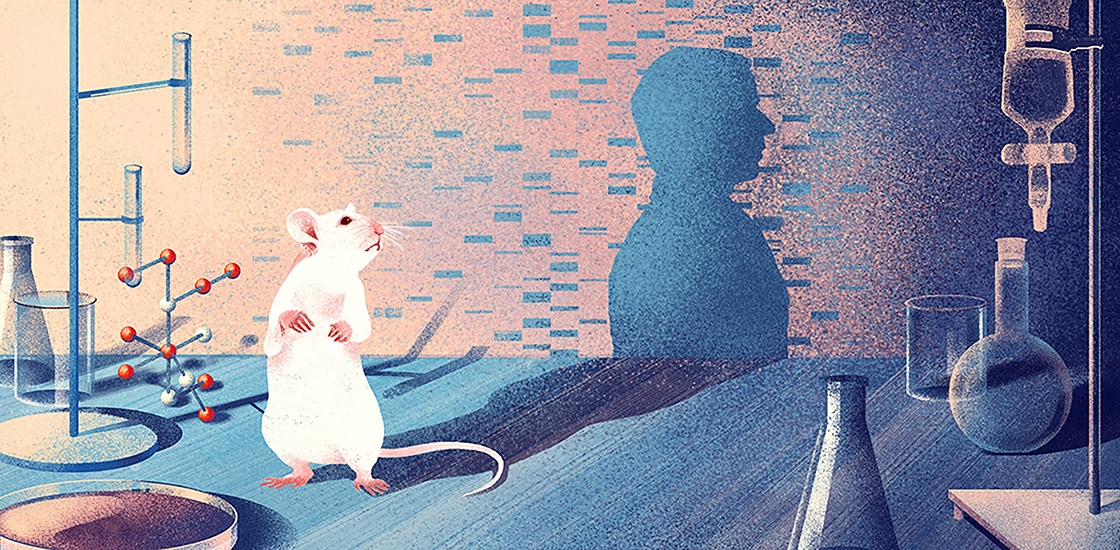THIS ARTICLE IS MORE THAN FIVE YEARS OLD
This article is more than five years old. Autism research — and science in general — is constantly evolving, so older articles may contain information or theories that have been reevaluated since their original publication date.

In Rudolf Jaenisch’s lab at the Massachusetts Institute of Technology (MIT) are mice that at first glance look like any other lab rodent. But on closer inspection, one can see that their white fur is speckled with tiny brown patches — made up of cells that originated from an African-American person1.
These mouse-human hybrids are the first examples of so-called ‘chimeric’ animals that carry functional human cells, says Jaenisch, professor of biology at MIT. In fact, these and similar hybrids may hold the key to decoding conditions such as autism.
Ethical concerns dog their creation, however. Scientists and policymakers worry that ‘humanized’ animals could end up with humanized brains. If human neurons underlie human thought, could — and should — these animals be considered human?
With such concerns in mind, in September 2015, the National Institutes of Health (NIH) called for a moratorium on the creation of certain human-animal chimeras. The ruling applies to chimeras created by introducing human cells into early embryos of mice, allowing the cells to multiply and potentially dominate the brain and body.
But in November, a group of biologists and clinicians argued that such concerns are far-fetched. In a letter to Science, they called the NIH notice “a threat to progress in stem cell biology, developmental biology and regenerative medicine.”
Last month, the NIH proposed amending the ruling to allow early-stage chimeras in mammals, excluding nonhuman primates. Meanwhile, work on mouse-human hybrids in accordance with NIH policy proceeds apace. Spectrum spoke to Jaenisch about the benefits — and potential pitfalls — of creating chimeras.
Spectrum: Why do researchers want to study mouse-human chimeras?
Rudolf Jaenisch: Traditionally, researchers have studied human conditions by mutating the responsible genes in mice. In some cases, these mice mimic the human condition well. For example, mouse models of Rett syndrome, which is caused by mutations in the MeCP2 gene, show molecular, cellular and behavioral features similar to those of people with the syndrome. They have helped researchers develop therapies that are now in clinical trials.
But in other cases, mouse models do not work well. Take Lesch-Nyhan syndrome, which is caused by a mutation in a gene called HPRT. Mice lacking HPRT are totally normal. It took 10 years for people to figure out why: Mice have an enzyme that humans don’t have, and that compensates for lack of HPRT.
One alternative approach is to transplant mature human cells into mice. But this does not allow us to understand the initiation and progression of a condition, only its manifestation. Human stem cells, which can still differentiate, allow researchers to track these cells across the lifespan of the mouse. This has the greatest potential for modeling human conditions in animals.
S: Is it possible to create mice with human cells throughout the body?
RJ: To create a mouse with contributions from human stem cells in all its organs, researchers would need to introduce truly ‘naïve’ human stem cells — those that can become any cell type in the body — into embryos that are still just a ball of cells, or blastocysts.
The conventional human stem cells are not naïve, but are already on the path to differentiating. These cells are not suitable for generating such chimeras. Researchers have tried to generate naïve human stem cells equivalent to those from mice. Some have published examples of such cells and claim to have produced human-mouse chimeric embryos2. We have been unable to reproduce these findings3.
Instead, we have worked on ways to use ‘committed’ stem cells, those already on the path to becoming a certain subset of cells in the body. We have focused on neural crest cells, which migrate over long distances and form the peripheral nervous system, the whole pigment system and the autonomic nervous system. It is an amazing population of cells.
We introduced human neural crest cells in utero into mouse embryos at a time when the host neural crest cells begin to populate the body. We used mice that carry a mutation that prevents them from making their own versions of these cells. In this experiment, we generated mice that carry dark-pigmented skin cells derived from the stem cells of an African-American donor. It was the first demonstration of mice harboring human cells that are actually functional.
S: What could you do with these chimeras?
RJ: We can use them study diseases of neural crest derivatives, such as skin cancer. We plan to use neural crest cells from individuals with a genetic predisposition to melanoma and see how this predisposition influences cancer initiation, progression and manifestation in the animal.
We are also working on introducing human stem cells that could become neurons into mouse brains. We could potentially engineer mice that carry some neurons derived from a person with Alzheimer’s disease, Parkinson’s disease or autism. We could then study how genetic changes affect these neurons across the mouse’s life. There would be too few human neurons to have an effect on the animal’s behavior, but we could track cell-specific changes. And these chimeras could help us assess possible therapies. For example, you could test whether a drug bypasses the blood-brain barrier to influence the human cells.
S: How do you view the ethical concerns about chimeras?
RJ: The NIH moratorium was based on concerns about using pluripotent cells, because these could become any cell in the body. The question was raised: “Would human cells in the mouse brain affect the ‘personality’ of the mouse? Would the mouse become ‘humanized?’” I don’t think that’s a problem. We expect that only a small fraction of cells would be human in such an animal. Mice and people are just so different. It’s not a human — there’s no way.
It would be encouraging if the NIH decides to support making chimeras in mice, because these experiments are expensive and important for studying human conditions.
I think a real ethical concern arises if you introduce human cells into nonhuman primates, such as chimpanzees. Human cells might survive well in a primate host and make up a large part of the animal. At what point would it become essentially human?

By joining the discussion, you agree to our privacy policy.